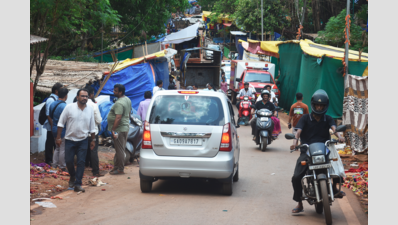Panaji: A 4m-wide pathway lined with stalls on both sides, a frenzied crowd at a religious event and a nighttime gathering with inefficient
crowd control measures. The
Shirgao jatra ticked most of the boxes in the National Disaster Management Authority’s list of triggers for a stampede.
The authority’s guidebook for managing crowds at events, shared with state govt, proves that despite the annual religious gathering possessing all the ingredients for a stampede, authorities and organisers did little to implement the NDMA’s recommendations.
“In India, religious places have a high probability of crowd disasters. Obviously, their locations have also played some role in crowd disasters. A large number of religious sites are located atop hills. There is a need for long-term perspectives for infrastructure development which should depend on popularity, periodicity of event, weather, terrain, local population, etc. Staging points should be planned for physical locations through which each visitor must pass,” said the NDMA document.
The temple village of Shirgao is geographically a small one. Most of it is hilly, and the rest is taken up by mining and agricultural land.
The houses lie on either side of the straight road along the north-south direction on the hill’s shoulder.
With narrow roads from Poira in the south and Assonora in the north serving as both entry and exit points to the Lairai jatra venue, and the core fair and festival area located along the same short road stretch, the table-top venue was always a death trap for thousands of ‘dhonds’ and devotees.
“The stalls are lined up along the approach roads from Assonora and Poira, too. And there is not much space in our mining-devastated area for expansion,” said Dinanath Gaonkar, president, Laira Sansthan.
But this is not the only red flag that was ignored. “The excessive wait at places of worship may result in a few devotees climbing up the fences, which could lead to a large number following them causing overcrowding in another area,” states the NDMA document.
Devotees say that a mere three-hour window exists for 70,000 ‘dhonds’ to walk over the burning embers past midnight, with the crowds already in a frenzy.
The NDMA SOP for crowd control warns that organising
religious events along narrow streets with vendors on both sides requires scientific planning and proper coordination between authorities and the stakeholders to avoid crushing of the devotees.
Drawing from stampedes at railway stations, religious shrines, and sporting events, the NDMA had provided all the states with a list of triggers for crowd disasters. The NDMA said that higher than anticipated numbers at religious sites, where there is a wild rush, is a perfect recipe for disaster. The reliance on one major entry and exit route is a major red flag, according to the NDMA document.
Devotees arriving from both sides struggle to negotiate the congested road lined with stalls, shops and houses. “If less space is given to stalls and shops, and they are prevented from encroaching on the road, there could be more space for devotees,” said Vijay Gaonkar, president, Shirgao comunidade.









